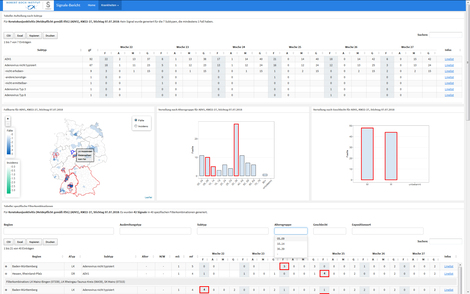Signale - Projects
The Signale project is supported by the Federal Ministry of Health. Its mission and objectives are defined in the application "DEMIS Signale 2" linked below at the end of this page (in German). We are also partner in the "ESEG" project.
Focus Group AI for Health, Topic Group Outbreaks
The FG-AI4H is an initiative of the International Telecommunication Union (ITU) and the World Health Organization (WHO). It aims at developing standards for the evaluation of artificial intelligence (AI) approaches in health. We coordinate the subgroup TG Outbreaks, which addresses the benchmarking of outbreak detection algorithms. Further information under https://www.itu.int/en/ITU-T/focusgroups/ai4h/Pages/default.aspx
Signal reports
The core mission of the Signale team is the development of the early-warning system of the RKI. A detailed description (as of May 2015) has been published in Eurosurveillance and is attached at the end of this page.
The early-warning system aims at detecting notable events automatically and quickly from surveillance data. It is mainly about possible outbreaks, but other "anomalies" can be of interest. The strength of the system is to indicate quickly, through the analysis of a large quantity of data, where a closer epidemiological investigation might be useful.
Concretely a signal is defined as a "statistically unlikely accumulation of cases within a week". This is an indication for a possible outbreak, not a proof.
The signal detection works as follows:
1. a "filter combination" is chosen, i.e. a combination of properties like pathogen, sex or reporting place;
2. all reported cases that correspond to the filter combination are aggregated in a time series;
3. the number of cases that can be expected today for this time series under normal conditions is estimated;
4. an upper bound is determined, above which the case count of today can be considered abnormal;
5. if the observed case is indeed above the upper bound, a signal is generated for the given filter combination.
These steps are done for a large number of different filter combinations.
The signal reports are provided to our colleagues in public-health agencies. Please contact us should you be interested in receiving them!

 The signal reports give an overview of the signals of the last 6 weeks for a selection of diseases. They consist in an HTML file containing two tables, a map, and two bar charts for age and sex. The reports are interactive: One can sort and filter the tables; zoom in the map, show either case count or incidence, as well as county or state names; and much more.
The signal reports give an overview of the signals of the last 6 weeks for a selection of diseases. They consist in an HTML file containing two tables, a map, and two bar charts for age and sex. The reports are interactive: One can sort and filter the tables; zoom in the map, show either case count or incidence, as well as county or state names; and much more.
Machine learning
We apply and adapt methods of machine learning to improve outbreak detection, evaluate and optimise existing algorithms, and gain new insights about how infectious diseases spread, e.g. through the integration of external data.
Interactive dashboards
We develop custom automatic analyses and interactive visualisations, made available within the RKI as dashboards. They allow the dynamic exploration of the epidemic situation and the uncovering of correlations.
BeSSA: Berliner Syndromische Surveillance in Notunterkünften für Asylsuchende
For the BeSSA project we have developed tools for outbreak detection and automatic reporting and advised domain experts on statistical questions. A description of the project and the tool for outbreak detection can be found at http://www.rki.de/synsurvrefugees
to the top




